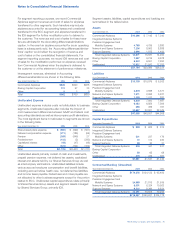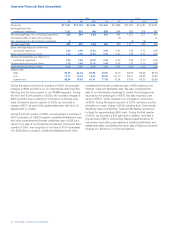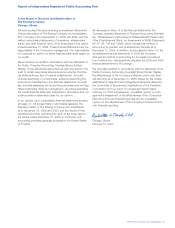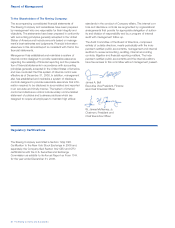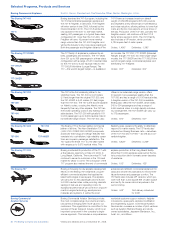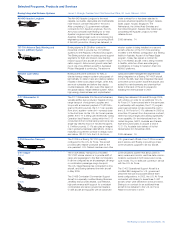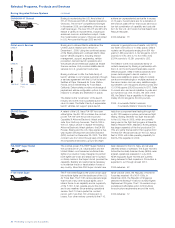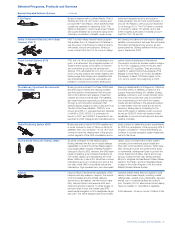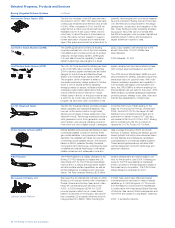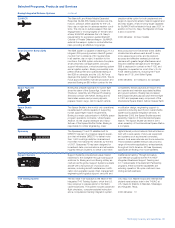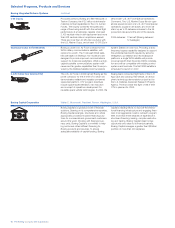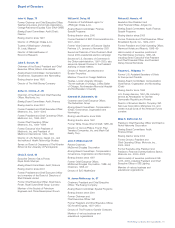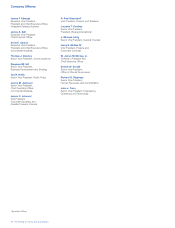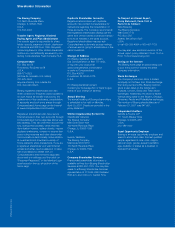Boeing 2006 Annual Report Download - page 91
Download and view the complete annual report
Please find page 91 of the 2006 Boeing annual report below. You can navigate through the pages in the report by either clicking on the pages listed below, or by using the keyword search tool below to find specific information within the annual report.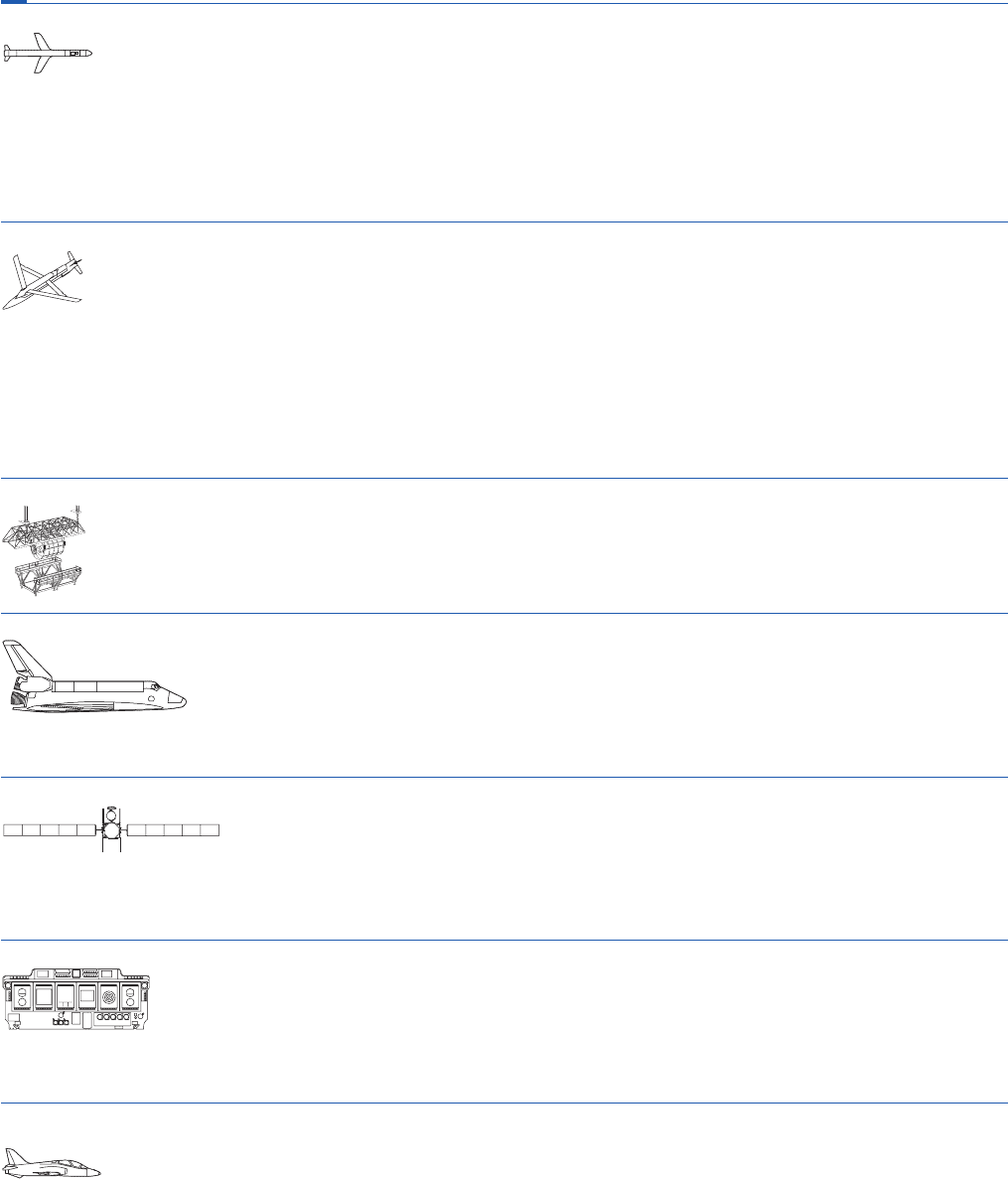
T-45 Training System The two-seat T-45 Goshawk is the heart of the
integrated T-45 Training System, which the U.S.
Navy employs to prepare pilots for the fleet’s
carrier-based jets. The system includes advanced
flight simulators, computer-assisted instruction
and a computerized training integration system.
U.S. Navy, U.S. Marine Corps and international
student naval aviators train in the T-45A/C at
U.S. Naval Air Stations in Meridian, Mississippi,
and Kingsville, Texas.
2006 deliveries: 13
Space Payloads Boeing has prepared payloads for space flight
since the dawn of the Space Age. Under the
Checkout, Assembly and Payload Processing
Services contract with NASA, Boeing and its
teammates receive and process payloads,
prepare mission cargo, test for launch vehicle
compatibility, extract payloads at mission end,
and operate and maintain associated facilities
and ground systems. Boeing has processed
every Space Shuttle payload since the first flight
in 1981 and prepares every component of the
International Space Station before it leaves Earth.
Space Shuttle The Space Shuttle is the world’s only operational,
reusable launch vehicle capable of supporting
human space-flight mission requirements.
Boeing is a major subcontractor to NASA’s space
program operations contractor, United Space
Alliance. As the original developer and manu-
facturer of the Space Shuttle Orbiter, Boeing is
responsible for orbiter engineering, major
modification design, engineering support to
operations (including launch) and overall shuttle
systems and payload integration services. In
September 2006, the Space Shuttle resumed
assembly missions of the International Space
Station. The Space Shuttle will retire in 2010
when assembly of the International Space Station
is complete.
Spaceway The Spaceway F1 and F2 satellites built for
DIRECTV are part of a massive capacity expan-
sion that will enable DIRECTV to deliver more
than 1,500 local high-definition channels and
more than 150 national HD channels by the end
of 2007. Spaceway F3 has been designed for
broadband data communications and will enable
Hughes Network Systems to deliver a full-mesh
digital Internet protocol network that will intercon-
nect with a wide variety of end-user equipment
and systems such as personal computers,
servers, local area networks and home networks.
This broadband satellite network will provide a
range of innovative applications, enterprisewide,
throughout North America. All three Spaceway
spacecraft are Boeing 702 model satellites.
Support Systems Support Systems provides best-value mission
readiness to the warfighter through total support
solutions for Boeing and non-Boeing military air-
craft across the globe. Support Systems sustains
aircraft with a full spectrum of products and
services, including aircraft maintenance, modifi-
cation and upgrades; supply chain management;
engineering and logistics support; and pilot and
maintenance training. Through innovative,
cost-effective programs like the F/A-18E/F
Integrated Readiness Support Teaming and
C-17 Globemaster III Sustainment Partnership
programs, these combined capabilities are
reducing operators’ life cycle costs and maxi-
mizing aircraft readiness.
Boeing Integrated Defense Systems continued
Small Diameter Bomb (SDB) The SDB system is capable of delivering a 113.4
kilogram (250-pound) precision standoff guided
munition from a distance of 60 nautical miles
in all weather, day or night. In addition to the
munitions, the SDB system includes a four-place
smart pneumatic carriage system, accuracy
support infrastructure, a mission-planning system
and a logistics system. Boeing successfully com-
pleted development and operational testing of
the SDB on schedule, and the U.S. Air Force
deployed the system in September 2006. The Air
Force approved SDB for full-rate production and
awarded Boeing an $80 million contract for the
third production lot in December 2006. SDB’s
miniaturized size allows each aircraft to carry
more weapons per sortie, and its precision
accuracy and effective warhead provide war
planners with greater target effectiveness and
reduced collateral damage around the target.
SDB is deployed in combat on the F-15E, and
integration is expected on most other U.S. Air
Force delivery platforms, including the F-22A
Raptor and F-35 Joint Strike Fighter.
2006 deliveries: 201 weapons, 35 carriages
The Boeing Company and Subsidiaries 89
Selected Programs, Products and Services
SLAM-ER The Standoff Land Attack Missile Expanded
Response (SLAM-ER) missile provides over-the-
horizon, precision strike capability for the U.S.
Navy day or night and in adverse weather condi-
tions. The only air-to-surface weapon that can
engage fixed or moving targets on the land and
at sea, SLAM-ER addresses the U.S. Navy’s
requirements for a precision-guided Standoff
Outside of Theater Defense weapon. SLAM-ER
extends the weapon system’s combat effective-
ness, providing an effective, long-range,
precision-strike option for both preplanned and
target-of-opportunity attack missions against land
and ship targets. A land moving-target capability
for SLAM-ER will be fielded in fiscal year 2007. In
addition to the U.S. Navy, the Republic of Korea
is also a customer.
2006 deliveries: 29 new missiles


